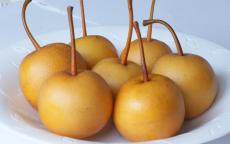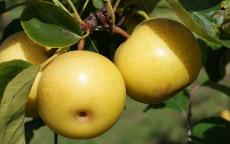- Related pear trees categories:
- Dessert pear trees28
- Cooking pear trees6
- Ornamental pear trees3
Asian pear trees
Asian pears belong to the species Pyrus pyrifolia and are closely related to our more common European pears (Pyrus communis). Asian pears are also known as Nashi pears, Chinese pears or Japanese pears - as the names suggest, this species originates in eastern Asia.
Despite the close relation, Asian pears have a very different character to European pears. They have a spherical shape, more like an apple than a pear. The flesh is also crisp like an apple.
The fruits are delicate and bruise easily, and hence are not often available in shops, so growing them at home is a good idea. They are usually eaten fresh (and usually peeled), and have a distinctive very sweet flavour, with little or no acidity. The pears can be stored in a fridge for a couple of months, or dried or frozen.
Like apples, and unlike most European pears, Asian pears are picked when they are ripe (European pears must usually be picked before they are ripe). Conversely, Asian pears cannot be picked before they are ripe because they will not continue to ripen after picking - another reason why these fruits are rarely available for sale.
Although the fruits may be very different, Asian pears grow in a similar way to European pears, and if you have a location which is good for European pears it will also be suitable for Asian pears. Furthermore, Asian and European pears will usually cross-pollinate if they are in flower at the same time.
Benita Rafzas®
Benita Rafzas is an unusual cross between an Asian and European pear.- Picking season: Early
- Self-fertility: Not self-fertile
- Flowering group: 2
Shinseiki
This popular Asian pear variety is well suited to the UK climate, and produces crisp sweet-flavoured pears.- Picking season: Early
- Self-fertility: Partially self-fertile
- Flowering group: 2


